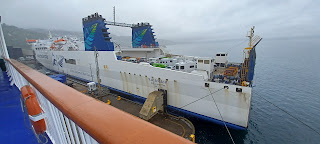Jeff and Shana
Wednesday, December 28, 2022
Auckland and Goodbye to New Zealand
Jeff and Shana
Sunday, December 25, 2022
North Island Highlights: Wellington, Rotorua, and Taraunga
After more than 2 weeks exploring the South Island, we took a ferry from Picton to Wellington. It was a rainy and foggy day so there wasn’t much to see along the way, which was disappointing because we knew that on a clear day the scenery would be amazing. Instead of sitting outside, we found a quiet inside corner and caught up on some reading. The view leaving Picton was lovely and here’s a photo of another ferry with lots of camper vans packed on to the deck. (People love traveling around NZ in camper vans, which seems cost-efficient but is definitely not our style.)
We had mostly gloomy weather in Wellington, so we don’t have many photos to share from our less than 48 hours there. Our activities included walking along the waterfront and visiting Te Papa Tongarewa / Museum of New Zealand. There is a terrific art collection, including many Māori artists, along with various cultural displays about Māori customs. During our time in NZ we enjoyed learning about Māori history and the evolution of the relationship between the Māori tribes and the government. NZ has done better than most countries with its indigenous population, but the historic mistreatment is still abhorrent.
From Wellington we flew to Rotorua. For Hobbit/Lord of the Rings fans, the airport terminal in Wellington has two giant eagles, one being ridden by Gandalf, made by Peter Jackson’s Weta Workshop. Pretty cool.
Rotorua, on the central eastern coast of the North Island, is well known as a geothermal region filled with geysers and hot pools. Our visit to Te Puia included a tour of the Māori Arts and Craft Institute, where we saw woodworkers in action, and a visit to the Kiwi Conservation Center, the only place we saw Kiwi birds -- the symbol of New Zealand. They are shy and nocturnal flightless birds that are difficult to encounter in the wild. The steaming geyser, which is the largest in the Southern Hemisphere was impressive even if we did not see it erupt.
We had one really packed day that started with a soak in the hot pools at the Polynesian Spa. We continued to Waimangu Volcano Valley to walk through the otherworldly landscape created by a massive 1886 volcanic eruption (the volcano, now not active, is in the bottom right photo below), and see the ongoing volcanic activity in the area (yes, the water in the second photo is practically boiling -- really cool). We finished the day on stand-up paddle boards exploring caves with glowworms within. It was a super interesting and fun-filled day. And, since the clouds cleared during our tour, we got our first really good look at a clear New Zealand night, and the amazing stars of the Southern Hemisphere.
On our way to Auckland, we stopped in Taraunga, a small coastal city where we hiked up Mount Maunganui. The very steep climb up was worth it for the views.
As you can see, NZ’s scenery continues to amaze us. We’re almost done with our NZ sojourn, but are already plotting to return soon.
Happy trails,
Shana & Jeff
PS – while in Auckland we watched an amazing documentary on Netflix recommended by my sister about one of NZ’s volcanoes – Whakaari / White Island, which erupted in 2019 and is in the Bay of Plenty, not that far from Taraunga. It was fascinating.
Tuesday, December 20, 2022
Around the South Island
Our final week on the South Island was a bit crazy. We drove a ton, took a cross-country train, and stayed in four different places. Nonetheless, we continued to enjoy the beauty of New Zealand.
Our week started with a drive from Queenstown to Dunedin (pronounced du-nee-din) on the east coast of the country. On the drive we stopped at the only official curing rink in the Southern Hemisphere; seriously, the week after we were there, the rink hosted a match of the Australian national team. We enjoyed learning about how to play curling, but with just the two of us, it was essentially a big game of shuffleboard. By the end, we were cold, but had gotten the hang of the game.
On the same day we took our penguin tour, we went to see the beautiful, but hard to access Tunnel Beach. On the way is this fantastic rock formation.The beach is small and peaceful, and there was a seal lazing on one of the rocks (black blob on the left in the picture below). Getting there and back was a bit harrowing as the tunnel to the beach is quite narrow and low.After leaving Dunedin, we drove back to Queenstown and caught a flight to Christchurch. After an overnight there, we caught the Transalpine train, which crosses the southern Alps to the west coast city of Greymouth. Although the trip was really beautiful, we have to admit that it did not have quite the "wow" factor that we were expecting; maybe it is because the mountains are just not that high. Still it was a very pleasant journey.Greymouth itself was not too interesting, but after a night there, we set off on a long drive to the northeast side of the island -- a town called Blenheim in the Marlborough wine region. Our first stop along the way was a really cool spot along the west coast called the Punakaiki Pancake Rocks (you can see why particularly in the bottom picture below).
Jeff and Shana



















































